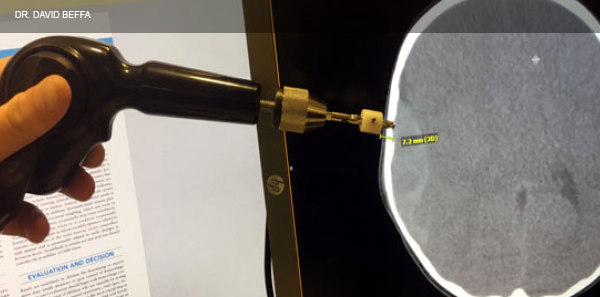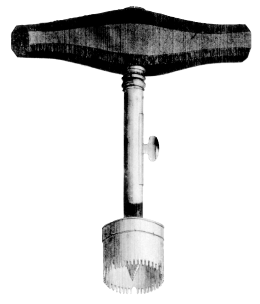
As a new medical director, I thought to myself, “What is the worst that could happen at our rural, 12-bed ED?” The scenarios we all know came to mind: pericardiocentesis, thoracotomy, lateral canthotomy, resuscitative endovascular balloon occlusion of the aorta, and skull trephination (burr hole). At our monthly departmental meetings, we reviewed all of these procedures so we would be ready. I ordered the necessary kits so we would have the tools on-site. Our hospital had never even had a skull trephination kit before. The one I ordered arrived the day before a 2-year-old patient arrived at triage.
Explore This Issue
ACEP Now: Vol 36 – No 12 – December 2017The Case
A 2-year-old male was brought to the emergency department by his mother after falling out of a shopping cart seat and striking his head. He initially appeared well and was running around the triage room. After a period of observation, he became increasingly somnolent, and on repeat exam, his pupils were slightly unequal. A head CT revealed a large epidural hematoma with midline shift. His pupils quickly became significantly worse at 6 mm and 2 mm, and he became unresponsive. I intubated him and called the nearest pediatric trauma center (one hour away) to begin arranging for helicopter transport. During the conversation with the trauma surgeon at the major academic center, I told him I was planning on doing an emergent burr hole. He said, “I’ve never done one of those—it’s up to you.”
I had seen one of these in residency and went to the supply room to find the newly arrived burr hole kit, took a deep breath, then started to prepare for the procedure by reviewing the CT.
I performed the burr hole with the technique described below and evacuated 150 mL of blood. The pupils improved. We placed a sterile dressing on the wound, and the helicopter team transported the patient to the pediatric trauma center.

Figure 2. Galt trephine.
NLM/Science Source
One month later, the mother brought the boy back to the emergency department. The patient was running around the emergency department with no deficits and gave me a hug.
Location to Drill
Emergency department skull trephinations are done in the temporal location 2 cm anterior and 2 cm superior to the tragus.1
Technique
- Measure the skull thickness on CT to set stopper depth (see Figure 1).
- Shave the hair with clippers; sterile prep and drape.
- Inject local anesthetic and then make a 4-cm vertical skin incision down to the periosteum at a point 2 cm superior and 2 cm anterior to the tragus.
- Use a periosteal elevator to expose the skull.
- Have an assistant hold the patient’s head firmly prior to drilling.
- Apply the trephine with gentle, steady pressure until the skull is penetrated. The two nonautomated choices for trephine are the Integra hand crank model with stopper (see Figure 1) and the Galt trephine (see Figure 2). The bone fragment may come out in the device or may need to be removed with forceps. Place the bone fragment in a sterile cup with saline.
- Once the bone fragment is removed, the clot may not immediately extrude. Use a small sterile pediatric suction catheter to facilitate hematoma drainage.
- If identified, the bleeding artery (usually the middle meningeal) may be ligated/clamped.1
Complications
- Emergency department skull trephinations should only be performed in the temporal region to avoid venous sinus injury and complications of air embolism or hemorrhage.
- Avoid plunging by using the stopper on the hand crank and by measuring skull thickness on the CT image.
- Infection is a possibility.
Historical Perspective
Trephinations of the skull have been found in human skulls older than 10,000 years of age. Skulls from virtually every major civilization show evidence of successful trephinations. There are three common methods for performing trephinations:2
Pages: 1 2 3 | Single Page




10 Responses to “How To Perform an Emergency Burr Hole Procedure”
December 28, 2017
Alexander KheradiWhat brand kit did you order for your department? Great article.
January 3, 2018
James NelsonHi Dr. Beffa,
Thank you for publishing this, as well as citing my review. We have learned a few practical things at our institution that I would like to share:
1) We find it easier, when encountered a clot that wont extrude, to irrigate gently with sterile saline. With patience, the clot will come out.
2) When you break the inner table of the skull with the Galt trephine, it is subtle. Check often for the bone fragment in the instrument.
3) Sometimes the bone fragment has broken free but does not pick up with the instrument. Probe the “disc” of bone and if loose, pick it up with Kelly forceps.
4) Don’t give up on a patient. My partner drilled on an elderly man comatose with herniating SDH. I thought he had no chance of survival, let alone recovery. He walked out of the hospital a month later.
5) Order a second Galt trephine.
Sounds like you are off to a great start as a medical director. That two year old will not be the only person you save thanks to your proactive work!
December 9, 2020
PradeepWow! It’s sounds just like one of those scenes from those medical dramas. I always wanna test my skills under pressure but at the same time i hope those situations doesn’t occurs to me. Kudos to you sir for keeping your cool and thanks for sharing your experiences
January 4, 2018
Nilantha LenoraGreat article, thanks for sharing.
If it’s all you have, would an EZ IO substitute for a Galt trephine? Would technique differ in any way?
January 15, 2018
Ira WoodFigure 1 apppeaes to be dangerously misleading. It could easily lead one to think that you set the depth stop on the drill by holding it up the CT image on your computer screen. Sure, if we stop and think about it, we all know that the CT images on our screen are not life-size, but I worry that, in the midst of a very stressful scenario, first thing someone will recall about this article is that image. There should be a reminder to use the software features to measure the thickness of the skull, and not try direct comparison, as shown in the image.
I have admit that this image pulled me in to read the article. I saw it and wondered how you were using the image to set the depth.
I realize that this sounds like common sense, but common sense is not as common as we’d like to think!
IW
January 15, 2018
Jeff LeinenGreat artical, great care, great Doctor
Thanks
January 16, 2018
Darrell Looney, MDI think the caliber of the EZ IO would be too small to allow removal of the clot, no?
September 6, 2019
Con DavUsing an IO device to make a circle of small holes and connect them has been described.
February 12, 2024
Charles Monday, Jr., M D FACS, retiredGS practice, rural, 70 mi N of Houston, Tx. Advised by lecturing neurosurgeon to NOT do burr hole for fear of lawsuit with this condition(having less than 10% chance of survival) based on pupil, etc. before we had C T Scanner.) Now we do, of course. However now, with handy helicopter service, the patient might reasonably burr holed by neurosurgeon within 90 minutes.
What to do?
September 2, 2025
Dr. Yvonne Chinonyerem Izuehie OnyeukwuNicely done👍🏽